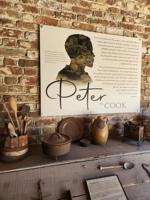Charleston is praised by hospitality publications for its rich culture, history and preserved landmarks.
What many don’t realize is how much influence African American and Gullah-Geechee cultures had, and still have, on the region’s tourism industry.
Alphonso Brown, owner of Gullah Tours, meets countless visitors in his line of work. He’s been driving busloads of them around Charleston for decades to give them an overview of his culture and heritage.
“People ask me all the time how I learned to speak Gullah. I say the better question is how did I learn to speak English?” Brown, a native Gullah speaker, joked.

Alphonso Brown is owner of Gullah Tours in Charleston.
The interest in Gullah culture has significantly grown over the years as he’s had to add more tour times and vehicles to keep up with demand.
“They come to hear Black history. They come to hear about what’s been left out of the history books,” Brown said. “There are truths that have taken a long time for people to accept, but now tour guides don’t hold back anything.”
The two-day 11th annual African American Tourism conference, held Oct. 4-5, put a spotlight on how that heritage is drawing in more visitors to the state each year.
A prime example is the International African American Museum, which made its debut in mid-2023. Visitors in line on the first day said the opening was what brought them to the city, but many extended their stays to see more historical sites, to sample local cuisine and to better understand Charleston’s Black history.
Renee McDaniel-Newkirk, communications director for the African American Tourism Council, said many of the things that visitors like about Charleston can be traced back to African American influences.
“People are interested in understanding history through stories,” McDaniel-Newkirk said. “We were more than just slaves. We were craftsmen, we were entrepreneurs and a lot of what our ancestors contributed to Charleston makes the city what it is today.”
The conference included workshops to help hospitality leaders learn more about marketing, funding and strategies to develop the niche within Charleston’s $13 billion industry and beyond.
The event typically draws more than 120 attendees, and while the pandemic in 2020 slowed attendance for a few years, it is back to pre-COVID levels. McDaniel-Newkirk said organizers also have had to adapt by incorporating information on new funding opportunities and the latest technologies, such as artificial intelligence, and the role that it can play in tourism marketing.
By the numbers
The council sees plenty of untapped potential in terms of attracting more African-American visitors and promoting and elevating the state’s Black culture.
African-American tourists generate about $2.4 billion in economic activity across South Carolina, according to a study by USC’s SmartState Center for Economic Excellence in Tourism and JC & Associates several years ago. The analysis, jointly funded by the council and the state, also showed a growing interest among travelers of all races in better understanding African-American heritage and cultural experiences — a trend that appears to be getting stronger.
“People see Hannibal’s Kitchen on Food Network and want to taste it for themselves,” McDaniel-Newkirk said. “People come to Charleston to experience life through our eyes. With that, we see a growing interest and heightened awareness of the rich, Black culture in Charleston.”
Duane Parrish, director of the S.C. Department of Parks, Recreation & Tourism, said drawing attention to the “rich Black history ingrained in South Carolina’s culture” is a key component of his agency’s “Discover South Carolina” campaign. In August, PRT was recognized with the highest honor from the U.S. Travel Association for state-level destination marketing.
“It focused on the opening of the International African American Museum and amplifying an array of diverse experiences and voices throughout the state,” Parrish said. “Sharing the broad spectrum of our state’s cultural tapestry with the world helps inspire more South Carolina vacations and benefits our economy.”
African American tourism is defined by visits by any race to African-American historic sites, themed events and festivals, tours and buildings — including churches, monuments, museums and restaurants serving traditional African-American and Gullah cuisine.
Providing guidance
Many Black Americans can trace their roots to the South along the Gullah Geechee Heritage Corridor, which covers four states from North Carolina to Florida and has its own organization.
Angel Parson, program director, said that while Gullah Geechee culture is most associated with South Carolina, and, more specifically, Charleston, its influence is more expansive.
Parson said there is a hunger for authentic experiences, inclusive storytelling and opportunities to learn about African American history and Gullah culture. She estimated that more than half of the calls her office receives are from visitors asking questions while trying to plan trips.
Cities that embrace authentic cultural experiences across their visitor industry — from museums and tours to dining — can “amplify and tell the story of the culture to a broader audience,” Parson said.
Among the recent examples is the Explore Black Charleston Guide that Charleston’s visitors bureau launched over the summer in response to growing interest since the opening of the International African American Museum last year. The publication is directory of significant historical landmarks, museums, tours and Black-owned restaurants and businesses across the region to help visitors plan their itineraries. It also serves as an educational tool about how the Black community has “influenced Charleston’s identity over time,” according to its website.
Chris Campbell, spokesman for Explore Charleston, said the guide was one way the tourism marketing organization could highlight the region as an inclusive destination and offer a “deeper understanding of the community’s complete history and support minority-led businesses that can benefit from the travel and hospitality industry.”

Jhaleeah Mitchell, 14, with Deninufay African Dance & Drum Production, leads members of the audience in dance steps during the Juneteenth on the Yard event at the International African American Museum in June.
Attraction factor
The International African American Museum drew nearly 188,000 visitors in its first year, half of whom were from South Carolina. The IAAM sold out tickets in advance leading up to and for months following the launch. The first-year metrics aligned with research published by the tourism council, which found a many African American tourists who visit the area are based in the South.
The museum has promoted its “authentic storytelling” as its biggest draw since its conception. Malika Pryor, chief learning and engagement officer, said it’s a jumping-off point.
“We can offer a holistic story of the International African American experience and the African diasporic experience, often utilizing examples from the Lowcountry. No matter how much square footage we have, we just cannot tell the whole story. That’s where other institutions and partners in the community can add their value to the narrative,” Pryor said, noting that IAAM staffers regularly direct visitors to resources like the Avery Research Center at the College of Charleston.
Books and art continue to sell out at the IAAM’s gift shop, which Pryor sees as a sign that the museum offers enough eclectic content and narratives that inspire leave visitors to learn more.
It’s not the only site adding more to the conversation. Many of the area’s historic plantation attractions have added more context and guided tours on African-American contributions.
Also, the Charleston Museum is set to expand its reach past the Civil War to delve into the Reconstruction, Jim Crow, Charleston Renaissance and Civil Rights eras and beyond. Among the artifacts featured in the new exhibit opening Oct. 24 will be a church pew from an Edisto Island sanctuary made by enslaved people.
The Meeting Street museum collaborated with Millicent Brown, who was among the first Black children to integrate South Carolina schools in the early 1960s and the lead plaintiff in a landmark desegregation lawsuit, in designing the sections of the exhibit focused on African-American history.
“We’re proud of the depth of storytelling from times of slavery to beyond the Civil Rights movement,” said Carl Borick, director.









